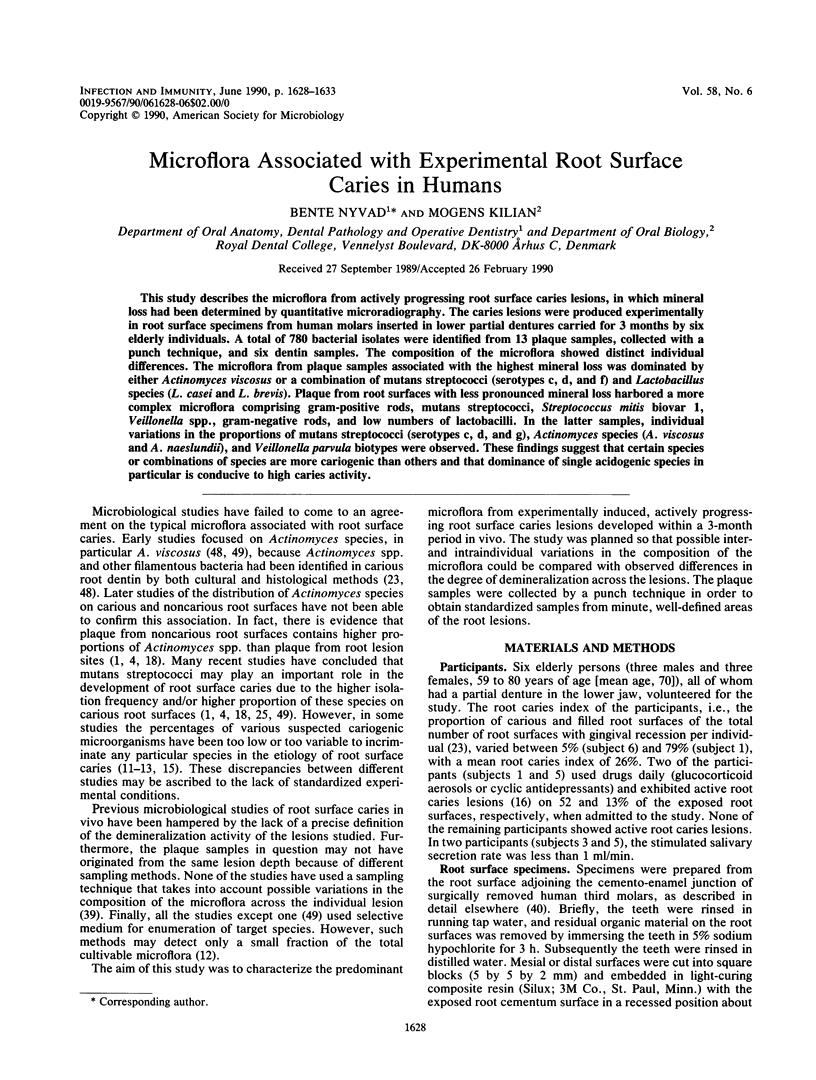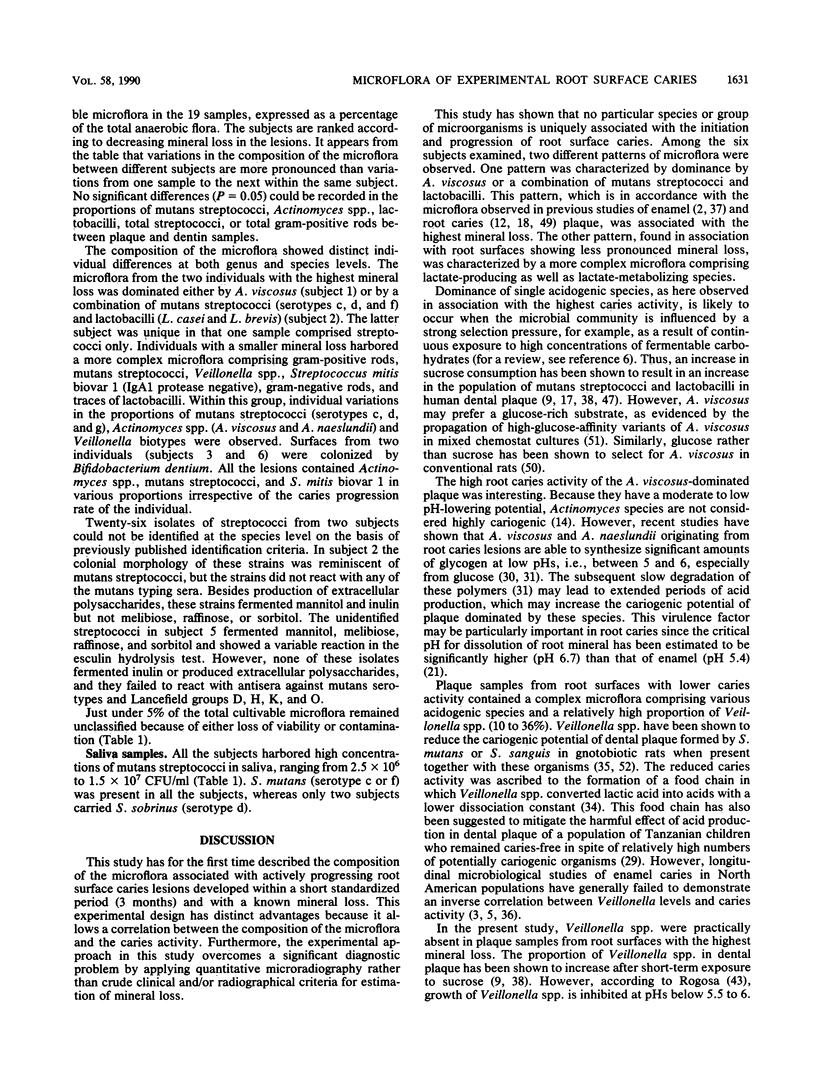Abstract
This study describes the microflora from actively progressing root surface caries lesions, in which mineral loss had been determined by quantitative microradiography. The caries lesions were produced experimentally in root surface specimens from human molars inserted in lower partial dentures carried for 3 months by six elderly individuals. A total of 780 bacterial isolates were identified from 13 plaque samples, collected with a punch technique, and six dentin samples. The composition of the microflora showed distinct individual differences. The microflora from plaque samples associated with the highest mineral loss was dominated by either Actinomyces viscosus or a combination of mutans streptococci (serotypes c, d, and f) and Lactobacillus species (L. casei and L. brevis). Plaque from root surfaces with less pronounced mineral loss harbored a more complex microflora comprising gram-positive rods, mutans streptococci, Streptococcus mitis biovar 1, Veillonella spp., gram-negative rods, and low numbers of lactobacilli. In the latter samples, individual variations in the proportions of mutans streptococci (serotypes c, d, and g), Actinomyces species (A. viscosus and A. naeslundii), and Veillonella parvula biotypes were observed. These findings suggest that certain species or combinations of species are more cariogenic than others and that dominance of single acidogenic species in particular is conducive to high caries activity.
Full text
PDF





Selected References
These references are in PubMed. This may not be the complete list of references from this article.
- Billings R. J., Brown L. R., Kaster A. G. Contemporary treatment strategies for root surface dental caries. Gerodontics. 1985 Feb;1(1):20–27. [PubMed] [Google Scholar]
- Boyar R. M., Bowden G. H. The microflora associated with the progression of incipient carious lesions of children living in a water-fluoridated area. Caries Res. 1985;19(4):298–306. doi: 10.1159/000260859. [DOI] [PubMed] [Google Scholar]
- Brown L. R., Billings R. J., Kaster A. G. Quantitative comparisons of potentially cariogenic microorganisms cultured from noncarious and carious root and coronal tooth surfaces. Infect Immun. 1986 Mar;51(3):765–770. doi: 10.1128/iai.51.3.765-770.1986. [DOI] [PMC free article] [PubMed] [Google Scholar]
- Burt B. A., Loesche W. J., Eklund S. A. Stability of selected plaque species and their relationship to caries in a child population over 2 years. Caries Res. 1985;19(3):193–200. doi: 10.1159/000260843. [DOI] [PubMed] [Google Scholar]
- Denepitiya L., Kleinberg I. A comparison of the acid-base and aciduric properties of various serotypes of the bacterium Streptococcus mutans associated with dental plaque. Arch Oral Biol. 1984;29(5):385–393. doi: 10.1016/0003-9969(84)90165-1. [DOI] [PubMed] [Google Scholar]
- Dennis D. A., Gawronski T. H., Sudo S. Z., Harris R. S., Folke L. E. Variations in microbial and biochemical components of four-day plaque during a four-week controlled diet period. J Dent Res. 1975 Jul-Aug;54(4):716–722. doi: 10.1177/00220345750540040401. [DOI] [PubMed] [Google Scholar]
- Ellen R. P., Banting D. W., Fillery E. D. Longitudinal microbiological investigation of a hospitalized population of older adults with a high root surface caries risk. J Dent Res. 1985 Dec;64(12):1377–1381. doi: 10.1177/00220345850640121001. [DOI] [PubMed] [Google Scholar]
- Ellen R. P., Banting D. W., Fillery E. D. Streptococcus mutans and Lactobacillus detection in the assessment of dental root surface caries risk. J Dent Res. 1985 Oct;64(10):1245–1249. doi: 10.1177/00220345850640101301. [DOI] [PubMed] [Google Scholar]
- Ellen R. P., Fillery E. D., Banting D. W. Comparison of selective broth and plating methods for isolation of Streptococcus mutans from root surface dental plaques. J Clin Microbiol. 1980 Mar;11(3):205–208. doi: 10.1128/jcm.11.3.205-208.1980. [DOI] [PMC free article] [PubMed] [Google Scholar]
- Ellen R. P., Onose H. pH measurements of Actinomyces viscosus colonies grown on media containing dietary carbohydrates. Arch Oral Biol. 1978;23(2):105–109. doi: 10.1016/0003-9969(78)90146-2. [DOI] [PubMed] [Google Scholar]
- Emilson C. G., Klock B., Sanford C. B. Microbial flora associated with presence of root surface caries in periodontally treated patients. Scand J Dent Res. 1988 Feb;96(1):40–49. doi: 10.1111/j.1600-0722.1988.tb01406.x. [DOI] [PubMed] [Google Scholar]
- Folke L. E., Gawronski T. H., Staat R. H., Harris R. S. Effect of dietary sucrose on quantity and quality of plaque. Scand J Dent Res. 1972;80(6):529–533. doi: 10.1111/j.1600-0722.1972.tb00325.x. [DOI] [PubMed] [Google Scholar]
- Fure S., Romaniec M., Emilson C. G., Krasse B. Proportions of Streptococcus mutans, lactobacilli and Actinomyces spp in root surface plaque. Scand J Dent Res. 1987 Apr;95(2):119–123. doi: 10.1111/j.1600-0722.1987.tb01817.x. [DOI] [PubMed] [Google Scholar]
- Hamada S., Masuda N., Ooshima T., Sobue S., Kotani S. Epidemiological survey of Streptococcus mutans among Japanese children. Identification and serological typing of the isolated strains. Jpn J Microbiol. 1976 Feb;20(1):33–44. doi: 10.1111/j.1348-0421.1976.tb00905.x. [DOI] [PubMed] [Google Scholar]
- Harper D. S., Loesche W. J. Effect of pH upon sucrose and glucose catabolism by the various genogroups of Streptococcus mutans. J Dent Res. 1983 May;62(5):526–531. doi: 10.1177/00220345830620050101. [DOI] [PubMed] [Google Scholar]
- Hoppenbrouwers P. M., Driessens F. C., Borggreven J. M. The mineral solubility of human tooth roots. Arch Oral Biol. 1987;32(5):319–322. doi: 10.1016/0003-9969(87)90085-9. [DOI] [PubMed] [Google Scholar]
- Jensen S. B., Löe H., Schiött C. R., Theliade E. Experimental gingivitis in man. 4. Vancomycin induced changes in bacterial plaque composition as related to development of gingival inflammation. J Periodontal Res. 1968;3(4):284–293. doi: 10.1111/j.1600-0765.1968.tb01934.x. [DOI] [PubMed] [Google Scholar]
- Jordan H. V., Hammond B. F. Filamentous bacteria isolated from human root surface caries. Arch Oral Biol. 1972 Sep;17(9):1333–1342. doi: 10.1016/0003-9969(72)90166-5. [DOI] [PubMed] [Google Scholar]
- Katz R. V. Assessing root caries in populations: the evolution of the root caries index. J Public Health Dent. 1980 Winter;40(1):7–16. doi: 10.1111/j.1752-7325.1980.tb01844.x. [DOI] [PubMed] [Google Scholar]
- Keltjens H. M., Schaeken M. J., van der Hoeven J. S., Hendriks J. C. Microflora of plaque from sound and carious root surfaces. Caries Res. 1987;21(3):193–199. doi: 10.1159/000261021. [DOI] [PubMed] [Google Scholar]
- Kilian M., Bülow P. Rapid diagnosis of Enterobacteriaceae. I. Detection of bacterial glycosidases. Acta Pathol Microbiol Scand B. 1976 Oct;84B(5):245–251. doi: 10.1111/j.1699-0463.1976.tb01933.x. [DOI] [PubMed] [Google Scholar]
- Kilian M. Rapid identification of Actinomycetaceae and related bacteria. J Clin Microbiol. 1978 Aug;8(2):127–133. doi: 10.1128/jcm.8.2.127-133.1978. [DOI] [PMC free article] [PubMed] [Google Scholar]
- Kilian M., Thylstrup A., Fejerskov O. Predominant plaque flora of Tanzanian children exposed to high and low water fluoride concentrations. Caries Res. 1979;13(6):330–343. doi: 10.1159/000260423. [DOI] [PubMed] [Google Scholar]
- Komiyama K., Khandelwal R. L., Duncan D. E. Glycogen synthetic abilities of Actinomyces viscosus and Actinomyces naeslundii freshly isolated from dental plaque over root surface caries lesions and non-carious sites. J Dent Res. 1986 Jun;65(6):899–902. doi: 10.1177/00220345860650060701. [DOI] [PubMed] [Google Scholar]
- Komiyama K., Khandelwal R. L., Heinrich S. E. Glycogen synthetic and degradative activities by Actinomyces viscosus and Actinomyces naeslundii of root surface caries and noncaries sites. Caries Res. 1988;22(4):217–225. doi: 10.1159/000261109. [DOI] [PubMed] [Google Scholar]
- Llory H., Dammron A., Gioanni M., Frank R. M. Some population changes in oral anaerobic microorganisms, Streptococcus mutans and yeasts following irradiation of the salivry glands. Caries Res. 1972;6(4):298–311. doi: 10.1159/000259809. [DOI] [PubMed] [Google Scholar]
- Masuda N., Tsutsumi N., Sobue S., Hamada S. Longitudinal survey of the distribution of various serotypes of Streptococcus mutans in infants. J Clin Microbiol. 1979 Oct;10(4):497–502. doi: 10.1128/jcm.10.4.497-502.1979. [DOI] [PMC free article] [PubMed] [Google Scholar]
- Mikx F. H., Van der Hoeven J. S. Symbiosis of Streptococcus mutans and Veillonella alcalescens in mixed continuous cultures. Arch Oral Biol. 1975 Jul;20(7):407–410. doi: 10.1016/0003-9969(75)90224-1. [DOI] [PubMed] [Google Scholar]
- Mikx F. H., van der Hoeven J. S., König K. G., Plasschaert A. J., Guggenheim B. Establishment of defined microbial ecosystems in germ-free rats. I. The effect of the interactions of streptococcus mutans or Streptococcus sanguis with Veillonella alcalescens on plaque formation and caries activity. Caries Res. 1972;6(3):211–223. doi: 10.1159/000259801. [DOI] [PubMed] [Google Scholar]
- Milnes A. R., Bowden G. H. The microflora associated with developing lesions of nursing caries. Caries Res. 1985;19(4):289–297. doi: 10.1159/000260858. [DOI] [PubMed] [Google Scholar]
- Minah G. E., Loesche W. J. Sucrose metabolism in resting-cell suspensions of caries associated and non-caries-associated dental plaque. Infect Immun. 1977 Jul;17(1):43–54. doi: 10.1128/iai.17.1.43-54.1977. [DOI] [PMC free article] [PubMed] [Google Scholar]
- Minah G. E., Lovekin G. B., Finney J. P. Sucrose-induced ecological response of experimental dental plaques from caries-free and caries-susceptible Human volunteers. Infect Immun. 1981 Dec;34(3):662–675. doi: 10.1128/iai.34.3.662-675.1981. [DOI] [PMC free article] [PubMed] [Google Scholar]
- Nyvad B., ten Cate J. M., Fejerskov O. Microradiography of experimental root surface caries in man. Caries Res. 1989;23(4):218–224. doi: 10.1159/000261181. [DOI] [PubMed] [Google Scholar]
- Perch B., Kjems E., Ravn T. Biochemical and serological properties of Streptococcus mutans from various human and animal sources. Acta Pathol Microbiol Scand B Microbiol Immunol. 1974 Jun;82(3):357–370. doi: 10.1111/j.1699-0463.1974.tb02338.x. [DOI] [PubMed] [Google Scholar]
- Qureshi J. V., Goldner M., Riche W. H., Hargreaves J. A. Streptococcus mutans serotypes in young schoolchildren. Caries Res. 1977;11(3):141–152. doi: 10.1159/000260260. [DOI] [PubMed] [Google Scholar]
- ROGOSA M. THE GENUS VEILLONELLA. I. GENERAL CULTURAL, ECOLOGICAL, AND BIOCHEMICAL CONSIDERATIONS. J Bacteriol. 1964 Jan;87:162–170. doi: 10.1128/jb.87.1.162-170.1964. [DOI] [PMC free article] [PubMed] [Google Scholar]
- Staat R. H., Gawronski T. H., Cressey D. E., Harris R. S., Folke L. E. Effects of dietary sucrose levels on the quantity and microbial composition of human dental plaque. J Dent Res. 1975 Jul-Aug;54(4):872–880. doi: 10.1177/00220345750540042801. [DOI] [PubMed] [Google Scholar]
- Sumney D. L., Jordan H. V. Characterization of bacteria isolated from human root surface carious lesions. J Dent Res. 1974 Mar-Apr;53(2):343–351. doi: 10.1177/00220345740530022701. [DOI] [PubMed] [Google Scholar]
- Syed S. A., Loesche W. J., Pape H. L., Jr, grenier E. Predominant cultivable flora isolated from human root surface caries plaque. Infect Immun. 1975 Apr;11(4):727–731. doi: 10.1128/iai.11.4.727-731.1975. [DOI] [PMC free article] [PubMed] [Google Scholar]
- Van Palenstein Helderman W. H., Ijsseldijk M., Huis in 't Veld J. H. A selective medium for the two major subgroups of the bacterium Streptococcus mutans isolated from human dental plaque and saliva. Arch Oral Biol. 1983;28(7):599–603. doi: 10.1016/0003-9969(83)90007-9. [DOI] [PubMed] [Google Scholar]
- de Soet J. J., Toors F. A., de Graaff J. Acidogenesis by oral streptococci at different pH values. Caries Res. 1989;23(1):14–17. doi: 10.1159/000261148. [DOI] [PubMed] [Google Scholar]
- van der Hoeven J. S. A slime-producing microorganism in dental plaque of rats, selected by glucose feeding. Chemical composition of extracellular slime elaborated by Actinomyces viscosus, strain Nyl. Caries Res. 1974;8(3):193–210. doi: 10.1159/000260109. [DOI] [PubMed] [Google Scholar]
- van der Hoeven J. S., Toorop A. I., Mikx R. H. Symbiotic relationship of Veillonella alcalescens and Streptococcus mutans in dental plaque in gnotobiotic rats. Caries Res. 1978;12(3):142–147. doi: 10.1159/000260324. [DOI] [PubMed] [Google Scholar]
- van der Hoeven J. S., de Jong M. H., Rogers A. H., Camp P. J. A conceptual model for the co-existence of Streptococcus spp. and Actinomyces spp. in dental plaque. J Dent Res. 1984 Mar;63(3):389–392. doi: 10.1177/00220345840630030601. [DOI] [PubMed] [Google Scholar]


